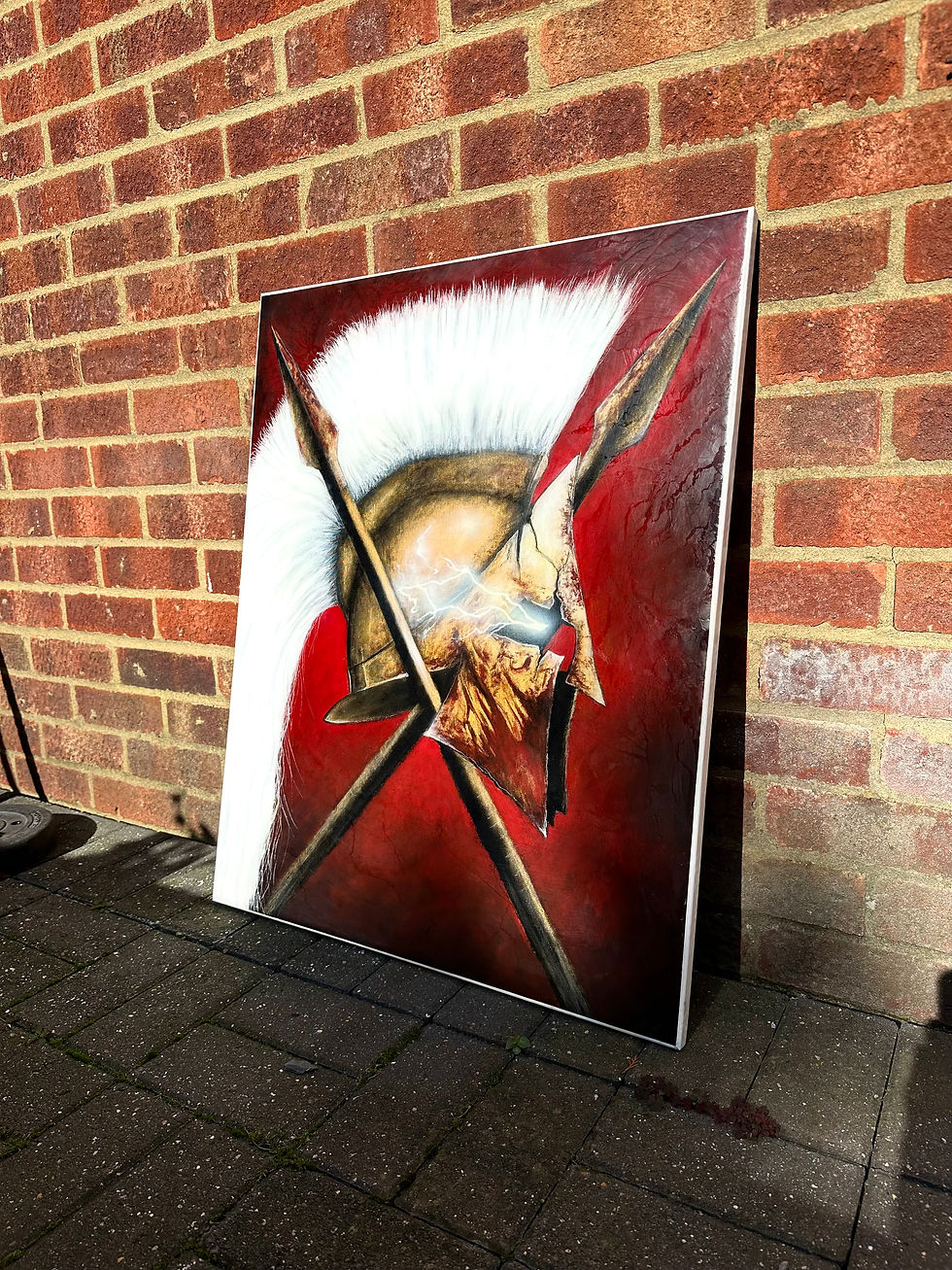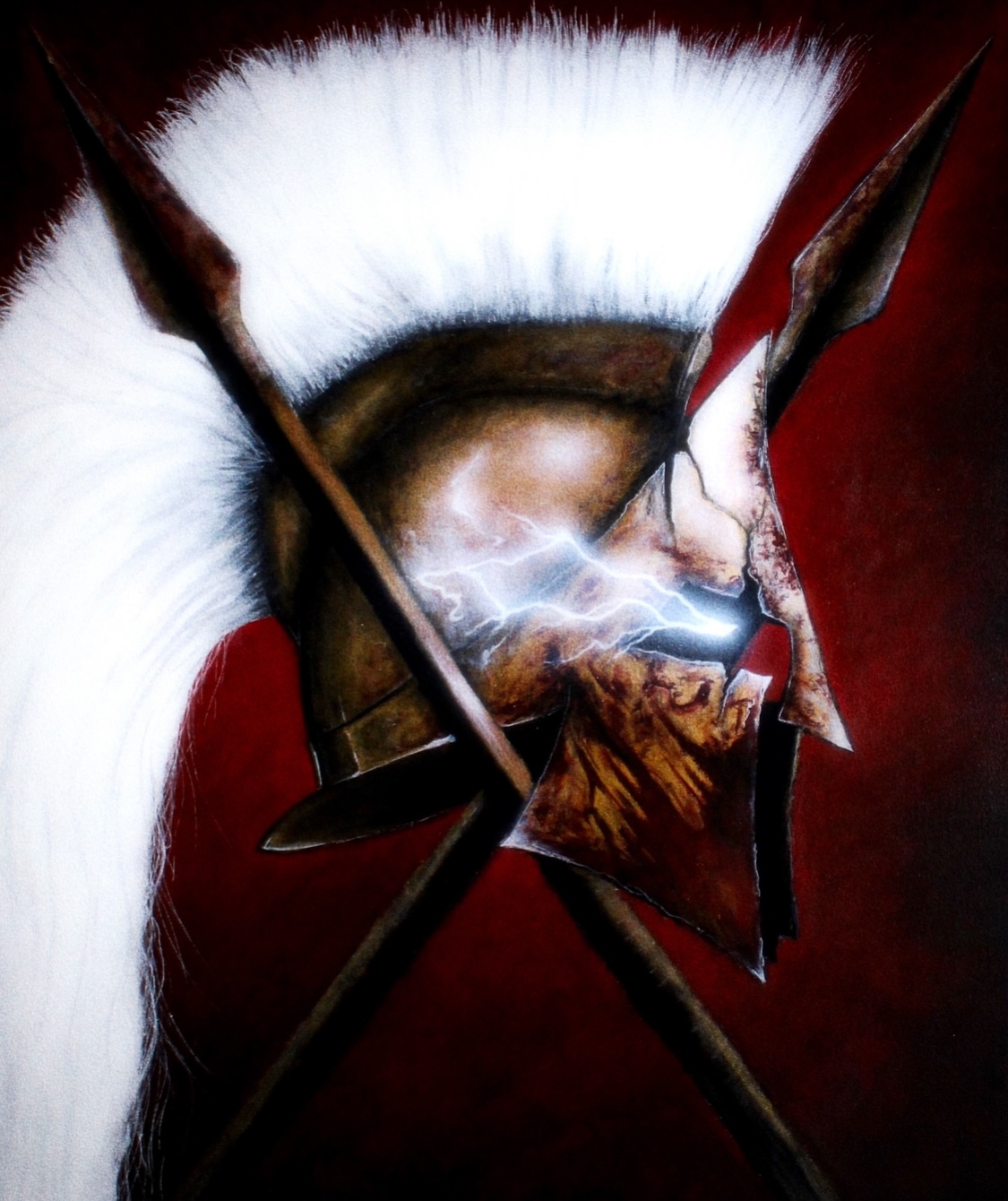My 'Molon Labe' Painting (Spartan Art)
- Mind Maestro
- Oct 14, 2023
- 6 min read
Updated: Oct 16, 2023

Molon Labe: A Glimpse into the Heart of Spartan Valor

Sparta, a city-state of ancient Greece, has captured the imagination of countless generations with tales of its unwavering bravery, unmatched military discipline, and indomitable spirit.
One of the most iconic phrases attributed to this city-state is "Molon Labe," which translates to "Come and take them."
This phrase is not just a collection of words; it's a testament to the Spartan ethos.
I tried to capture this very essence into this painting.
The story goes that when the Persian king Xerxes I demanded the Spartans surrender their weapons during the Battle of Thermopylae, King Leonidas I responded with "Molon Labe." The phrase encapsulates the essence of Spartan resistance and defiance.

The Spartan Painting: A Modern Homage to Ancient Bravery
The painting titled "Molon Labe" captures this spirit in vivid and electric detail.
Set against a backdrop of a deep crimson hue, evoking the blood spilled on the battlefields, the focal point is a Spartan helmet, worn and battle-scarred.
The plume on the helmet, traditionally a symbol of rank and stature, stands proud and unfazed, much like the Spartans themselves.
I employed shadow and light to accentuate the dents and wear on the helmet, telling tales of countless battles fought and won.
I used glow in the dark pigment mixed with titanium white to create an electric glow emulating from the eyes of this spartan.
Watch it come to life here:

Symbolism and Interpretation
The spears that cuts diagonally across the frame serves as a stark reminder of the Spartan's primary weapon and their mastery in wielding it. It divides the canvas, symbolizing the line the Spartans drew between them and their adversaries, a line that dared their enemies to cross.
In the modern world, "Molon Labe" has been adopted as a symbol of resistance and defence of individual rights.
My Spartan helmet painting, with its intricate detailing and powerful imagery, is not just a piece of art but also an emblem that resonates with those who value honour, bravery, and freedom.
The Spartan Way has echoed through eternity. Synonymous with strength, honour & integrity, the Spartan Helmet has become a symbol for the warrior mindset, one which I have revitalised into a unique colour wave with an electrified perception.
They say it’s better to be a warrior in a garden then a gardener in a war....
What do you think?
I finished this painting off by adding resin to create a vibrant glow to the piece.
The resin will allow it to stand the test of time, reminiscent of the spartan legacy, but I also purposely burnt the resin slightly with a heat gun to create a shattered effect that streaks throughout the painting.
With subtle cracks and scars it emphasises the power and impact of the spartan warriors while also giving it a unique look. When light hits the painting it either brings out all of the colour, or it shimmers off the texture of the cracks.
This is still one of my favourite paintings to date.
Also I have made this original spartan painting available for purchase too.
If you are interested in making this your own, click here to learn more.
For those interested in learning more about the ancient Spartans, the rest of this article will dive a little deeper into their history, ethos, culture and more.
And if you want to immerse yourself completely, I created the ultimate experience.
It is 'The Way of the Spartans'

Spartans: More than Warriors
When you hear "Spartan," you might think of fierce warriors.
But there's more to their story. These ancient Greeks were not just fighters; they were a community with a unique way of life that still inspires today.
If you want to read my complete deep dive into the Spartans, you can read my article here
A Glimpse into Ancient Greece
Ancient Greece was a collection of city-states, each with its flavour.
Among them, Sparta stood out. Unlike Athens, known for democracy and arts, Sparta was all about discipline and military might.
From childhood, Spartans trained to be the best warriors, always ready for battle, especially fearing a revolt from the Helots, their largest population.
Women in Sparta
Spartan women had a unique role in Spartan Culture.
They were educated, athletic, and powerful. With men often at war, women managed properties and households.
They were seen as pillars of society, ensuring strong future generations. One famous Spartan woman, Gorgo, once cleverly remarked about the strength of Spartan women, highlighting their importance.
Epic Battles
Sparta's reputation wasn't just built on discipline; it was earned in battle.
Thermopylae: King Leonidas and 300 Spartans bravely faced King Xerxes' vast Persian army. They fought valiantly, becoming symbols of courage.
Plataea: After Thermopylae, the Greeks united against the Persians. Led by Sparta, they achieved a significant victory, stopping the Persian advance.
Peloponnesian War: A long conflict between Athens and Sparta, showcasing their differences. Sparta eventually won, but at a great cost.
I also have an article about the history of the Spartans here
Spartan Society
Sparta's society was layered. The top tier was the Spartiates, full citizens trained for war. Then came the Perioikoi, free but non-citizens, and at the bottom, the Helots, the enslaved majority. Religion and shared meals were vital, promoting unity and reminding Spartans of their duties.
Spartan Quotes to Remember
"With it or on it." Spartan mothers' advice to their sons about their shields, emphasizing honor.
"Come back with your shield, or on it." A reminder of the importance of bravery.
"If." King Leonidas's defiant response to the Persians, showing Spartan spirit.
"We are what we repeatedly do. Excellence, then, is not an act, but a habit." A reflection of the Spartan way of life.
"He is not dead; he has merely taken his place in the ranks of his ancestors." A tribute to a fallen Spartan's honour.

In Conclusion
The Spartans were more than just warriors. They were a community bound by shared values. Their stories of bravery and discipline remind us of the power of unity and shared purpose. Today, as we face our challenges, the lessons from Sparta inspire us to be resilient, united, and purposeful.
Explore More Spartan Art by The Mind Maestro
You can explore my Spartan Art gallery by clicking the button below!
FAQs about Spartans
What was Sparta's art?
Spartan art was minimalistic and functional, reflecting their austere way of life. They did produce pottery, sculptures, and metalwork, but they were more simplistic and pragmatic compared to the elaborate artistry of other Greek city-states like Athens.
Did people in Sparta like art?
While Spartans appreciated art, they did not prioritize it as highly as their military training and discipline. Spartan society was more focused on warfare and physical fitness than artistic pursuits.
What does Spartan symbol mean?
The most well-known Spartan symbol is the lambda (Λ), which stands for "Lacedaemon", the name of the region in which Sparta was located. The lambda was often emblazoned on Spartan shields and signified the unity and strength of Sparta.
What is the famous Spartan sculpture?
One of the most famous Spartan sculptures is the "Leonidas at Thermopylae" statue by Jacques-Louis David. It depicts King Leonidas, one of the most famous Spartan kings, who led the 300 Spartans at the Battle of Thermopylae.
Who is the most famous Spartan?
King Leonidas I is perhaps the most famous Spartan. He is best known for leading a small force of Spartans against the Persian army at the Battle of Thermopylae in 480 B.C.
What was the original Spartan symbol?
The original Spartan symbol was the lambda (Λ) representing "Lacedaemon". Over time, other symbols, like the image of a hoplite or warrior, became associated with Sparta.
What were Spartans famous for?
Spartans were most famous for their military prowess, discipline, and the rigorous training of their warrior class, the hoplites. Their society was structured around warfare and preparation for battle.
Why were Spartans so feared?
Spartans were feared because of their exceptional military training, discipline, and bravery in battle. From a young age, Spartan boys were trained to be warriors, undergoing intense physical and mental training.
What is Sparta now called?
Modern Sparta, which is a shadow of its ancient self in terms of power and prestige, is called "Sparti" or "Sparta" and is located in the Laconia region of Greece.
Are Spartans the most powerful?
In their prime, the Spartans were considered one of the most powerful military forces in ancient Greece. However, their power was eventually eclipsed by other city-states and empires.
How did Sparta fall?
Sparta's decline began after their defeat by Thebes at the Battle of Leuctra in 371 B.C. Over the next centuries, Sparta faced internal conflicts, political upheavals, and was eventually conquered by the Achaean League and later the Romans.
Are Spartans stronger than Vikings?
Comparing Spartans and Vikings is challenging since they existed in different periods and regions. Both were fierce warriors in their own right, with unique strengths and tactics. A direct comparison is speculative, as they never encountered each other in battle.
_edited_edited.png)



































Comments